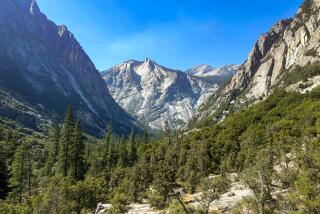Vegas in the raw
Las Vegas — VEGAS has gone back to its beginnings. Not the Bugsy Siegel ones, but the Stone Age ones.
On June 8, the city opened the most unlikely of attractions: the Las Vegas Springs Preserve. The 180-acre tract about four miles northwest of the Strip marks the spot where a natural spring helped give the city its name (“the meadows,” in Spanish). Though the spring all but dried up half a century ago, it’s now the heart of a new non-gaming attraction that aspires to be the Central Park of Las Vegas.
“The Springs Preserve was developed to create a sense of place, a sense of identity for Las Vegas,” said director Francis N. Beland, whose prior gig was designing the Shark Reef aquarium at the Mandalay Bay hotel-casino.
“We’re such a great metropolis now, but I think we grew so fast that the social and cultural fabric for a city of this size is missing. I don’t think it’s missing because people don’t want it or don’t want to invest in it -- it’s simply missing because we grew too fast.”
The ambitious, $250-million project includes more than 176,000 square feet of museums, educational galleries and interactive exhibits; more than 30,000 plants in an expansive botanical garden; and 2 1/2 miles of trails -- with more planned. Also coming is a 79,000-square-foot Nevada State Museum, expected to open in 2009.
The tale of the city’s manic growth and its effect on the environment is just a tiny fraction of the 1.5-billion-year history of the region that is explained in the main building, the Origen Experience.
Here, from a tall glass rotunda lobby with trickling waterfalls, visitors can see early Native American dwellings and a reenactment display of the 1905 land auction that kicked off modern Las Vegas development. Throughout the Origen Experience are cages and hutches full of exotic spiders, turtles and other desert critters.
Over at the Desert Living Center, five buildings -- including one with a garbage truck made from recycled materials -- is the primary education center where classes and guest lectures are held. One display explains the construction of one of the buildings, from the recycled wood beams to the straw bale that acts as wall insulation. The gardens outside are lined with several species of indigenous cactuses, palms and other desert-friendly flora.
The preserve has earned the highest rating from the U.S. Green Building Council for its use of straw bale-constructed buildings, recycled carpeting and solar-power receptors that serve both as an energy source and as shade for cars in the parking lot. Even the cafeteria-style Wolfgang Puck restaurant, which is set to open this month, aims to fit in with a menu dominated by organic ingredients, crate-free veal and eggs from free-range hens.
But as natural as all this sounds, the preserve offers some Vegas-y touches, such as an attraction-cum-thrill-ride where visitors stand on a platform to experience a simulated flash flood by using lights, noise and 5,000 gallons of water bursting through the room.
Or the display that shows how water is pumped from Lake Mead to the Stratosphere hotel-casino, or an arcade of games for children that includes faux slot machines that play various educational videos whenever the symbols line up.
And every Vegas opening needs a singing act. Jewel performed June 9 at an outdoor concert in the 1,800-seat amphitheater.
“I just love the idea that this is right there, that Las Vegas is starting to care about its environment and history,” the singer-songwriter said.
It’s not just out-of-towners surprised to discover what was being built amid the urban jungle they traverse.
“I work over there at the Meadows Mall across the street, and until recently I had no idea that this land was here, that they were planning this,” said Georges Hernandez, 48, of North Las Vegas. “It’s brilliant.”
Beland has his eye on drawing at least 750,000 visitors a year. He points out that about 6% of the 40 million annual visitors to Las Vegas go off the Strip for activities such as touring Hoover Dam.
“This is probably the greatest stroke of counter-programming I’ve ever heard of,” said Danielle Renault of Bakersfield, who toured the complex on its opening day. “For a while, everyone who comes here is going to feel like they’ve stumbled across a well-kept secret.”
--
(BEGIN TEXT OF INFOBOX)
THE PLACE
The Las Vegas Springs Preserve is across from the western entrance to Meadows Mall. It features eight acres of botanical gardens, 2 1/2 miles of trails, a Wolfgang Puck restaurant and a gift shop (that may be accessed for free, although all visitors must check in). Hours are 10 a.m. to 10 p.m. daily in summer months. Admission is $18.95 for adults, $17.05 for seniors, $13.45 for students, $10.95 for children 5 to 17. Children age 4 and younger are admitted free.
TO LEARN MORE
The preserve is at 333 S. Valley View Blvd., Las Vegas. Call (702) 258-7148 or go to www.springspreserve.org.
More to Read
Sign up for The Wild
We’ll help you find the best places to hike, bike and run, as well as the perfect silent spots for meditation and yoga.
You may occasionally receive promotional content from the Los Angeles Times.






